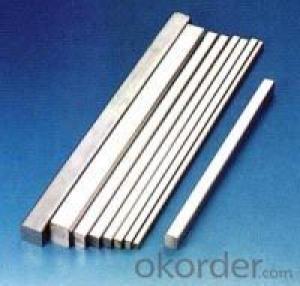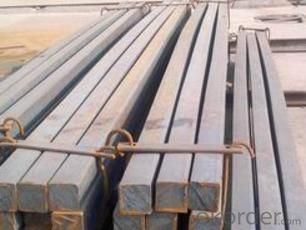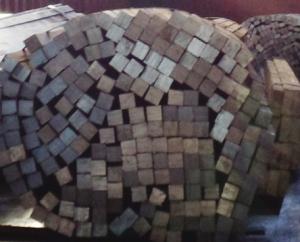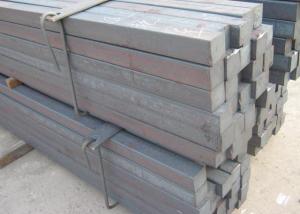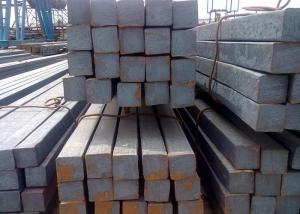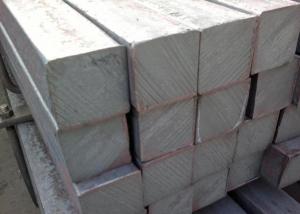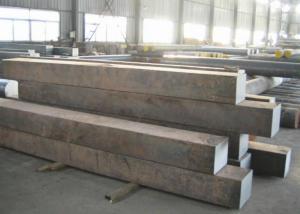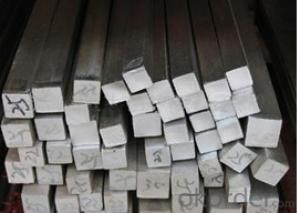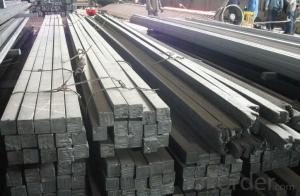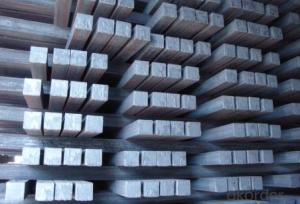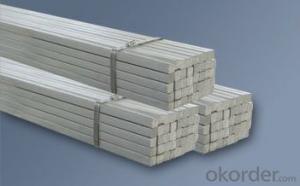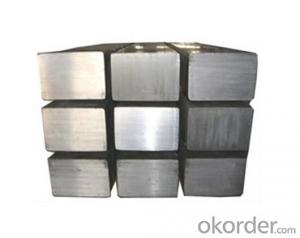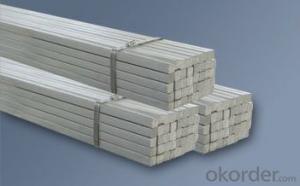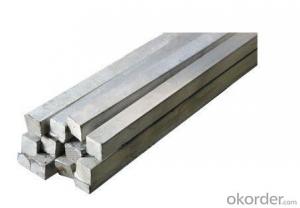Q275Cr High Quality Square Steel Bar
- Loading Port:
- Tianjin
- Payment Terms:
- TT OR LC
- Min Order Qty:
- 1000 m.t.
- Supply Capability:
- 100000 m.t./month
OKorder Service Pledge
OKorder Financial Service
You Might Also Like
Product Description:
Product Description:
In the production of steel products, steel is molded and reshaped with different machinery at different temperatures. One process is steel rolling, which involves metal stock passing through a pair of rolls. Rolling produces flat steel sheets of a specific thickness, and the process is classified according to the temperature at which the metal is rolled. If the temperature of the metal is above its recrystallization temperature, or the temperature at which the grain structure of the metal can be altered, then the process is termed as hot rolling. If the temperature of the metal is below its recrystallization temperature, the process is termed as cold rolling.
Like cold rolling, cold drawing is performed at room temperature, but instead of producing a flat object like a coke can, cold drawing makes steel into the form of a wire like the spokes of a wheel or a paper clip. To start the process, Steel is usual hammered and rolled so that it can be fit through a die; a tool that turns the steel mass into a wire. The room temperature steel is pulled through the die which reshapes it into a thinner shape while maintaining the same volume. It is similar to the idea of syrup flowing out of a bottle through a tube in that it changes shape but not volume, but instead of squeezing the metal, it is pulled out. In order to get the wire down to the right diameter, it usually requires more than one pass through different dies.
Colddrawn steel, steel covered carbon steel, excellent carbon steel, alloy structural steel, carbon tool steel, spring steel, bearing steel, tool steel, cold heading steel, free cutting steel, martensite stainless steel; products include all kinds of shapes round, square steel, hexagonal, flat steel and other conventional products, including various special-shaped steel products. In all types of colddrawn steel industry has been widely used, these areas include automotive, machine tools, furniture, standard parts, textile machinery, agricultural machinery, military industry and other industries.
The total assets of more than 40 million, as of the end of 2010 with fixed assets of 34 million, with 60 tons from 5 tons a chain drawing machine 10 sets, horizontal and inverted coiled wire drawing machine 5 sets, steel and plate production line of blasting, high-power ham stove, various straightening machine and cold rolling mill and other major equipment.
Usage/Applications
-The Square Bar is normally used as structure steel.
-Row material for other structure steel like steel angles, channels, I-beams, H-beams, etc…
Packaging & Delivery
-Packing Detail: The products can be packed in bundles by steel wires.
-Marks: We make tag marks and color marks. The tag marks with white background and red company logo will be tied up to each bundle of the products. The information is usually including basic information of products and company and other information requested by customers. As for color marks, we will paint both ends of bundles to make sure that it w
-Delivery Detail: 30~45 working days after receive buyer’s T.T. or L/C.
ill be more convenient for customers to distinguish them from other products.
- Q: Reinforced concrete and steel stairs to do the stairs which is better
- The rectangular steel tube is also not easy to makeThe stairs were made, and there was no concrete, and the stairs were steady and durable. Easy to vibrate and rust.
- Q: How is a steel square different from a regular square?
- A steel square, also known as a framing square or rafter square, is different from a regular square in terms of its material and specific design. Firstly, a steel square is made of durable and sturdy steel, which makes it more resilient and long-lasting compared to a regular square, which is often made of wood or plastic. This material difference allows the steel square to withstand heavy use, withstand harsh conditions, and maintain its accuracy over time. Secondly, a steel square has a unique design that sets it apart from a regular square. It typically has two arms, a long one called the body, and a shorter one called the tongue. These arms intersect at a 90-degree angle, forming the shape of an "L." The body of the steel square usually has various measurements and markings, such as inches, centimeters, and angles, allowing for precise measurements and calculations in construction and carpentry work. Additionally, a steel square often includes additional features that enhance its functionality, such as a level vial, scribe bar, and notches for determining roof pitches and angles. These added elements make the steel square a versatile tool for layout, marking, and measuring in various construction and woodworking applications. In summary, a steel square differs from a regular square with its material composition, being made of steel for durability, and its unique design and additional features that make it suitable for precise measurements and calculations in construction and carpentry work.
- Q: Are there any limitations to using a steel square?
- Yes, there are some limitations to using a steel square. Firstly, the size and weight of a steel square can make it difficult to handle, especially for individuals with limited strength or dexterity. This can make it challenging to use the square for prolonged periods or in complex projects where precise measurements are required. Secondly, steel squares are typically designed for right angles and straight measurements, which means they may not be suitable for projects that involve angles other than 90 degrees. In such cases, additional tools or techniques may be required to achieve the desired angles accurately. Thirdly, steel squares can be susceptible to rust and corrosion if not properly maintained. This can affect their accuracy over time, requiring regular cleaning and maintenance to ensure reliable measurements. Lastly, steel squares may not be suitable for certain materials or surfaces. For example, using a steel square on delicate or easily scratched materials like polished wood or glass may cause damage. In such cases, alternative measuring tools or protective measures may be necessary. Despite these limitations, steel squares are still widely used and valued for their sturdiness, durability, and accuracy in many woodworking, metalworking, and construction projects. However, it is important to be aware of their limitations and adapt accordingly when necessary.
- Q: 4*4 steel welding frame tank do strong?
- If you want to be firm, you can use the three and four sections. The middle slot can be clamped on the edge of the fish tank, and the tripod should be four. It's so convenient and strong!
- Q: Can a steel square be used for marking out through dovetail joints?
- Indeed, through dovetail joints can be marked out using a steel square. This flexible and precise instrument serves as a valuable aid in achieving accurate and perpendicular cuts during the creation of dovetail joints. By utilizing the steel square, one can effectively delineate the angles and measurements of the dovetail joint, thereby offering a reliable blueprint for precisely cutting and shaping the wooden material. Nevertheless, it is worth acknowledging that while a steel square is a beneficial asset, acquiring supplementary specialized tools like dovetail saws and chisels is also advantageous for attaining optimal outcomes when crafting dovetail joints.
- Q: Can a steel square be used for setting up a miter saw?
- Certainly! A miter saw can utilize a steel square for its setup. Known as a try square or carpenter's square, a steel square is a versatile tool that serves various woodworking purposes, including the setup of a miter saw. In setting up a miter saw, the steel square guarantees accuracy and alignment of the cutting angle. By positioning the square against the saw's fence and blade, it aids in determining if the blade is perpendicular to the fence. Moreover, the square assists in verifying the proper alignment of the miter gauge for precise angle cuts. In summary, a steel square plays a vital role in configuring a miter saw, ensuring precision and cleanliness in the cuts made.
- Q: How is a steel square different from a combination square?
- Carpentry and metalworking employ two distinct measuring tools: the steel square and the combination square. These tools differ in their characteristics and purposes. The steel square, also referred to as a framing square or carpenter's square, is a large tool shaped like an L, typically constructed from steel or aluminum. It consists of two arms, one longer than the other, and is primarily utilized for measuring and marking right angles. The blade, the longer arm, usually spans 24 inches, whereas the tongue, the shorter arm, measures around 16 inches. Construction tasks such as framing, stair layout, and squareness verification commonly rely on steel squares. Conversely, the combination square represents a versatile measuring instrument comprising a ruler or blade with an adjustable head that can be secured at varying angles. Its head incorporates a level bubble, a protractor scale, and a scribe or marking point. Unlike the steel square, the combination square permits precise measurements encompassing both angles and lengths. Woodworking, metalworking, and other trades that prioritize accuracy and adaptability often employ combination squares. Measuring and marking 45-degree and 90-degree angles, establishing miter cuts, and transferring measurements are among the tasks facilitated by combination squares. To summarize, the distinctive design and functionality separate the steel square from the combination square. The former serves as a straightforward L-shaped tool primarily geared towards measuring right angles, while the latter operates as a sophisticated measuring instrument capable of precise and versatile angle and length measurements.
- Q: Can a steel square be used for checking the squareness of a table saw fence?
- No, a steel square is not suitable for checking the squareness of a table saw fence. A specialized tool called a square fence gauge or a precision square should be used instead, as they are specifically designed for this purpose and offer greater accuracy.
- Q: How do you use a steel square for marking and cutting bridle joints?
- Achieving accurate and precise measurements when marking and cutting bridle joints using a steel square involves the following steps: 1. Prioritize cleanliness and ensure the steel square is free from debris and rust. This will aid in achieving accurate measurements. 2. Utilize a measuring tape or ruler to measure and mark the desired width and depth of the bridle joint on the wood. The width of the joint should be half the thickness of the wood, while the depth can vary depending on project requirements. 3. Align the steel square with the marked lines for the width and depth of the joint. Press the square firmly against the wood to prevent any movement or slippage. 4. Employ a marking knife or pencil to trace along the edge of the steel square, creating a clear and accurate guideline for cutting the bridle joint. Taking the time to ensure straight and precise lines is crucial. 5. With the lines marked, carefully cut along the traced lines using a saw or chisel. Employing sharp and suitable tools is essential for achieving clean and accurate cuts. 6. After cutting the bridle joint, use the steel square once again to verify the accuracy and squareness of the joint. Place the square against the cut edges to confirm they are perfectly perpendicular to the wood's face. At this stage, any necessary adjustments can be made to achieve a precise fit. Overall, a steel square is a vital tool for accurately and efficiently marking and cutting bridle joints. By following these steps, you can attain clean and precise joints that enhance the strength and appearance of your woodworking projects.
- Q: How do you use a steel square for creating accurate box joints?
- To use a steel square for creating accurate box joints, you will need to follow a step-by-step process. Here is how you can utilize a steel square effectively: 1. Start by selecting the appropriate size of steel square for your project. Steel squares are available in various sizes, so choose one that suits the dimensions of your box joints. 2. Measure and mark the desired length of your box joint on the edges of the mating boards. Ensure that the measurements are accurate and aligned properly. 3. Place the steel square against the edge of one of the boards, aligning the square's long side with the marked line for the box joint. Ensure that the square is firmly held against the board to prevent any movement. 4. Using a pencil or a marking knife, trace along the edge of the long side of the steel square, marking the line onto the board. This will create an accurate reference line for your box joint. 5. Repeat the process on the second board, aligning the steel square's long side with the corresponding marked line. Ensure that both boards have the same line marked on them for accurate box joints. 6. Now, adjust the steel square by 90 degrees, aligning the short side of the square with the marked line on the first board. Ensure that the square is securely held against the board. 7. Mark another line on the first board, following the edge of the short side of the steel square. This will create a perpendicular reference line to the first one, completing the box joint layout. 8. Repeat the process on the second board, using the same adjustment and alignment with the steel square as done on the first board. Ensure that both boards have the same perpendicular line marked on them for accurate box joints. 9. With the accurately marked reference lines, you can now proceed to cut the box joints using a saw or a router, following the marked lines precisely. Remember to always double-check your measurements and ensure that the steel square remains firmly in place during the marking process. Accuracy and attention to detail are crucial for creating precise box joints using a steel square.
Send your message to us
Q275Cr High Quality Square Steel Bar
- Loading Port:
- Tianjin
- Payment Terms:
- TT OR LC
- Min Order Qty:
- 1000 m.t.
- Supply Capability:
- 100000 m.t./month
OKorder Service Pledge
OKorder Financial Service
Similar products
Hot products
Hot Searches
Related keywords
